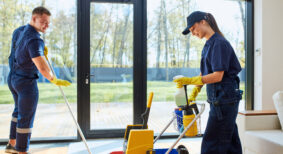COVID-19 has created a growing awareness about hygiene, particularly in public spaces. As buildings begin to reopen and stay-at-home orders are relaxed, facility managers are faced with navigating the complexities of a new normal as society returns to work. This includes reassuring employees and visitors of proper hygiene practices and managing their perception of hygiene, minimizing the spread of germs within a facility, and complying with stringent cleaning and disinfecting protocols.
People are holding the public places they visit, such as restrooms, to a much higher hygiene standard than ever before. In fact, according to a new survey conducted by Tork, 86 per cent of North American survey respondents say they expect public restrooms will provide a safer hygiene environment now than before the COVID-19 crisis.
Making your visitors feel safe
With COVID-19 rates varying across different cities, people are undoubtedly worried about their safety in public spaces. The study from Tork revealed that 77 per cent of people surveyed agree or strongly agree they feel more unsafe using facilities with unhygienic public restrooms due to COVID-19.
The increased concern for hygiene in public restrooms has led to an increased demand for paper hand towels, which are perceived as more hygienic than air dryers. According to the Tork study, 70 per cent of people in North America wish more facilities offered paper hand towels as an alternative to air dryers, and 33 per cent of people surveyed agree or strongly agree they feel unsafe entering a restroom with air dryers.
What’s behind this shift in preference? Some of the common reasons among survey respondents include the perceptions that:
- Paper hand towels are more hygienic to the user (71 per cent)
- Paper hand towels do not spread virus and bacteria in the air (43 per cent), and
- Paper hand towels dry hands more quickly (53 per cent)
This shift in consumer perception means facility managers must think twice about the hand dryer solutions in their facilities. While some managers might have previously chosen air dryers because they believed they were more convenient to use, a shift in consumer preference due to the pandemic has given many managers the push they need to make the switch to paper hand towels.
As facility managers continue to navigate what a safe and reassuring return to work looks like, they must also ensure they have the right protocols and products in place to maintain a new hygiene standard. By reinforcing hand hygiene rules as well as cleaning and disinfecting routinely, facility managers can help reduce the spread of COVID-19 in their facility and make employees and visitors feel safer.
Minimizing germ spread in your facility
While most experts agree COVID-19 is mainly spread through respiratory droplets that are produced when an infected person coughs, sneezes or talks, the virus can also spread through close personal contact, such as touching or shaking hands, or touching an object or surface with the virus and then touching your mouth, nose, or eyes.
Promoting good hand hygiene is critical to preventing the spread of germs in any given environment. Facility managers can reinforce hygiene standards in their facility by ensuring hand sanitizer and hand washing stations are easily accessible to employees and visitors in all parts of buildings and by keeping them fully stocked throughout the day. They should also consider posting signs near sinks, restrooms, and other high-traffic areas to remind people to wash their hands. These signs should stress the importance of frequent and thorough hand washing, especially after coughing, sneezing, using the toilet, or touching the trash.
In addition, facilities can limit contact between workers by making operational adjustments, such as extending or staggering working hours, staggering employee arrival and departure times, alternating days between working onsite and remotely, and instituting one-way foot traffic plans through office hallways and spacing out workstations so workers can physically distance while on the job.
Protective equipment should also be encouraged to promote workplace hygiene. While guidance on the use of face masks varies between localities, facility managers should ensure that protective equipment is available to employees and make sure to follow the guidance of local health authorities and government officials. Cleaning staff should always have easy access to personal protective equipment (PPE).
Creating cleaner spaces for employees
Because it is believed that employees can contract COVID-19 through contaminated surfaces, it is important to frequently clean and disinfect high-touch surfaces to reduce the spread of the virus, as well as other types of germs. This includes commonly-touched surfaces such as desks, tables, door handles, and elevator buttons, as well as shared objects including printers, keyboards, and phones. Disposable wipes should be easily available to employees so they can clean such surfaces and objects when needed.
Optimizing hand hygiene dispenser placement is another way to reinforce proper hand hygiene. When discussing facility floor plans, managers should make sure to place hygiene equipment in areas where there is a natural flow of traffic, including reception areas, restrooms, conference rooms, and break rooms. While each office is unique, the ultimate goal is ensuring that employees do not have to go out of their way to access a paper hand towel dispenser or hand sanitizer.
In the restroom, cleaners should begin with cleaning less-dirty surfaces before cleaning toilets and floors. Because mops and sponges can carry microorganisms, facilities should consider using disposable cleaning solutions, which help to reduce cross-contamination.
Rachel Olsavicky is the regional marketing manager – commercial and public interest at Essity Professional Hygiene. For more information, visit TorkUSA.com/saferchoice and TorkUSA.com/safeatwork.








